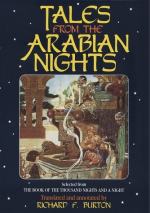On the other hand, a study of the vie intime in Al-Islam and of the manners and customs of the people proves that the body of the work, as it now stands, must have been written before A.D. 1400. The Arabs use wines, ciders and barley-beer, not distilled spirits; they have no coffee or tobacco and, while familiar with small-pox (judri), they ignore syphilis. The battles in The Nights are fought with bows and javelins, swords, spears (for infantry) and lances (for cavalry); and, whenever fire-arms are mentioned, we must suspect the scribe. Such is the case with the Madfa’ or cannon by means of which Badr Al-Din Hasan breaches the bulwarks of the Lady of Beauty’s virginity (i. 223). This consideration would determine the work to have been written before the fourteenth century. We ignore the invention-date and the inventor of gunpowder, as of all old discoveries which have affected mankind at large: all we know is that the popular ideas betray great ignorance and we are led to suspect that an explosive compound, having been discovered in the earliest ages of human society, was utilised by steps so gradual that history has neglected to trace the series. According to Demmin[FN#183], bullets for stuffing with some incendiary composition, in fact bombs, were discovered by Dr. Keller in the Palafites or Crannogs of Switzerland; and the Hindu’s Agni-Astar ("fire-weapon"), Agni-ban ("fire-arrow”) and Shatagni ("hundred-killer"), like the Roman Phalarica, and the Greek fire of Byzantium, suggest explosives. Indeed, Dr. Oppert[FN#184] accepts the statement of Flavius Philostratus that when Appolonius of Tyana, that grand semi-mythical figure, was travelling in India, he learned the reason why Alexander of Macedon desisted from attacking the Oxydracae who live between the Ganges and the Hyphasis (Satadru or Sutledge):- “These holy men, beloved by the gods, overthrow their enemies with tempests and thunderbolts shot from their walls.” Passing over the Arab sieges of Constantinople (A.D. 668) and Meccah (A.D. 690) and the disputed passage in Firishtah touching the Tufang or musket during the reign of Mahmud the Ghaznevite[FN#185] (ob. A.D. 1030), we come to the days of Alphonso the Valiant, whose long and short guns, used at the Siege of Madrid in A.D. 1084, are preserved in the Armeria Real. Viardot has noted that the African Arabs first employed cannon in A.D. 1200, and that the Maghribis defended Algeciras near Gibraltar with great guns in A. D. 1247, and utilised them to besiege Seville in A.D. 1342. This last feat of arms introduced the cannon into barbarous Northern Europe, and it must have been known to civilised Asia for many a decade before that date.




